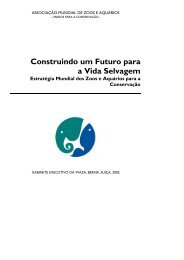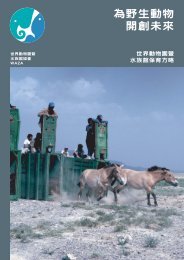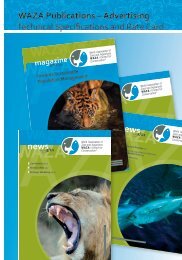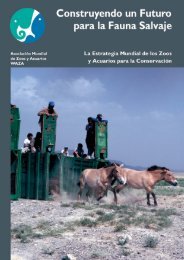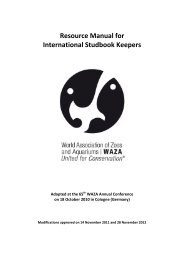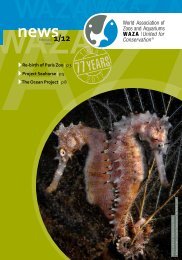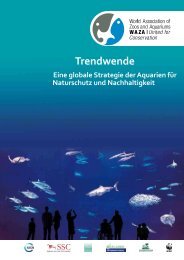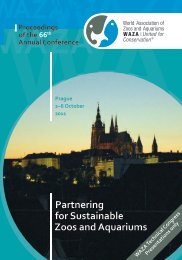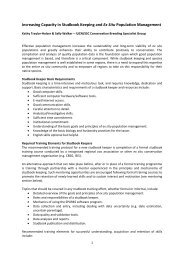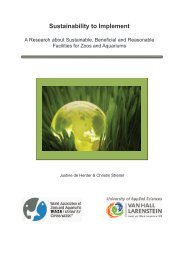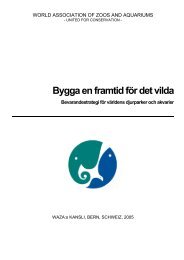Towards Sustainable Population Management - Waza
Towards Sustainable Population Management - Waza
Towards Sustainable Population Management - Waza
You also want an ePaper? Increase the reach of your titles
YUMPU automatically turns print PDFs into web optimized ePapers that Google loves.
WAZA magazine Vol 12/2011<br />
Fig. 1<br />
ASMP Health Check Report: percentage of scoring in each of three major portfolios and overall<br />
across 40 intensively managed exotic mammals in ZAA membership, where green (performing<br />
well), orange (needs some specific attention) and red (needs immediate attention).<br />
Legislation. The results of the Legislation<br />
portfolio have been useful in that<br />
legislative barriers have long been<br />
considered the significant cause for<br />
shortfall in programme performance<br />
(Fig. 1). It is clearly demonstrated that<br />
there is an ability to import a majority<br />
of the targeted exotic species<br />
into the region, and that interaction<br />
between New Zealand and Australia<br />
is also well supported by legislation<br />
(vital for effective Australasian-based<br />
programmes). There is a requirement<br />
from the Australian government<br />
for all species listed in Appendix I of<br />
the Convention on International<br />
Trade in Endangered Species of Wild<br />
Fauna and Flora (CITES) to have an<br />
approved Cooperative Conservation<br />
Plan in place prior to any international<br />
transaction and these are<br />
largely covered in regard to current<br />
need. As with other regions, the access<br />
to new founders is a challenge<br />
for a large number of programme<br />
species. The VPC threat category is<br />
a rating applied by the Australian<br />
government on the pest potential of<br />
a species to the environment (including<br />
public safety), if it were to escape<br />
and establish. The results here assist<br />
in identifying the promotion of appropriate<br />
biosecurity measures in our<br />
member zoos, which in turn provides<br />
confidence in granting permits to<br />
hold such species.<br />
Overall Performance. The overall<br />
performance scores (Fig. 1) show<br />
approximately 75% of all the exotic<br />
programmes within the sample either<br />
in good order (green) or with some<br />
specific issues (yellow).<br />
Conclusions<br />
ZAA Sustainability<br />
The Health Check Report process has<br />
allowed ZAA to commence a measured<br />
approach to the assessment<br />
of its intensively managed species<br />
programme performance. It is by no<br />
means exhaustive but does represent<br />
an ongoing commitment to self-assessment<br />
and a structured approach<br />
to problem solving, communicating<br />
priorities and deployment of resources.<br />
This will provide tangible benefits<br />
to supporting programme goals and<br />
assurances and value to the membership<br />
of ZAA who jointly fund the<br />
association’s activities.<br />
The process has allowed us to mobilise<br />
resources into the areas of most<br />
need. Recently the results have been<br />
fed into the region’s Taxon Advisory<br />
Group (TAG) structure, with each TAG<br />
charged with developing a specific<br />
action plan against any species with<br />
a red score. As a consequence, there<br />
has been support in aligning the<br />
actions of the TAGs, with a greater focus<br />
on animal husbandry and behaviour<br />
along with the identification of<br />
staff training and development. It is<br />
hoped that this will have a direct and<br />
positive impact in the areas of animal<br />
transfers and breeding.<br />
The legislative assessment has<br />
proven to be very productive, as it<br />
has long been considered throughout<br />
the membership as a primary<br />
limitation to programme progress.<br />
Although hoofstock imports continue<br />
to provide biosecurity challenges<br />
for the region due to the existing<br />
commercial livestock industry in both<br />
New Zealand and Australia, a majority<br />
of the other taxa can be imported<br />
under current legislation.<br />
9<br />
»



